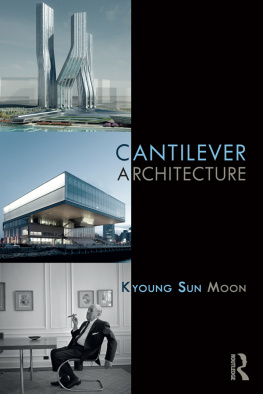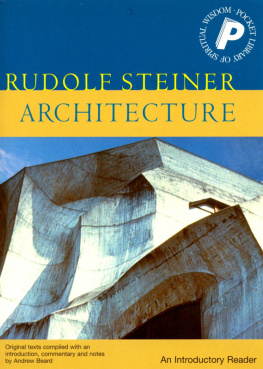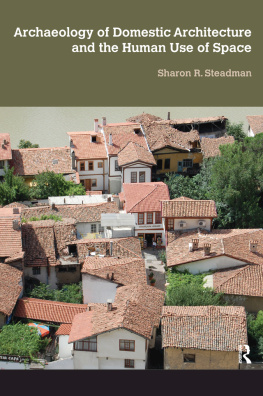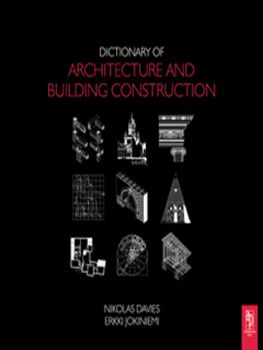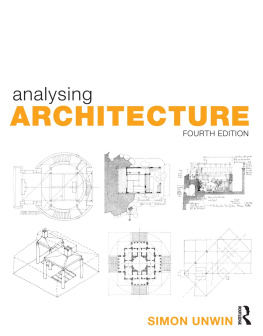Routledge. - Cantilever Architecture
Here you can read online Routledge. - Cantilever Architecture full text of the book (entire story) in english for free. Download pdf and epub, get meaning, cover and reviews about this ebook. City: New York, year: 2019, publisher: Taylor & Francis (CAM);Routledge Taylor & Francis Group, genre: Home and family. Description of the work, (preface) as well as reviews are available. Best literature library LitArk.com created for fans of good reading and offers a wide selection of genres:
Romance novel
Science fiction
Adventure
Detective
Science
History
Home and family
Prose
Art
Politics
Computer
Non-fiction
Religion
Business
Children
Humor
Choose a favorite category and find really read worthwhile books. Enjoy immersion in the world of imagination, feel the emotions of the characters or learn something new for yourself, make an fascinating discovery.
- Book:Cantilever Architecture
- Author:
- Publisher:Taylor & Francis (CAM);Routledge Taylor & Francis Group
- Genre:
- Year:2019
- City:New York
- Rating:3 / 5
- Favourites:Add to favourites
- Your mark:
- 60
- 1
- 2
- 3
- 4
- 5
Cantilever Architecture: summary, description and annotation
We offer to read an annotation, description, summary or preface (depends on what the author of the book "Cantilever Architecture" wrote himself). If you haven't found the necessary information about the book — write in the comments, we will try to find it.
Routledge.: author's other books
Who wrote Cantilever Architecture? Find out the surname, the name of the author of the book and a list of all author's works by series.
Cantilever Architecture — read online for free the complete book (whole text) full work
Below is the text of the book, divided by pages. System saving the place of the last page read, allows you to conveniently read the book "Cantilever Architecture" online for free, without having to search again every time where you left off. Put a bookmark, and you can go to the page where you finished reading at any time.
Font size:
Interval:
Bookmark:
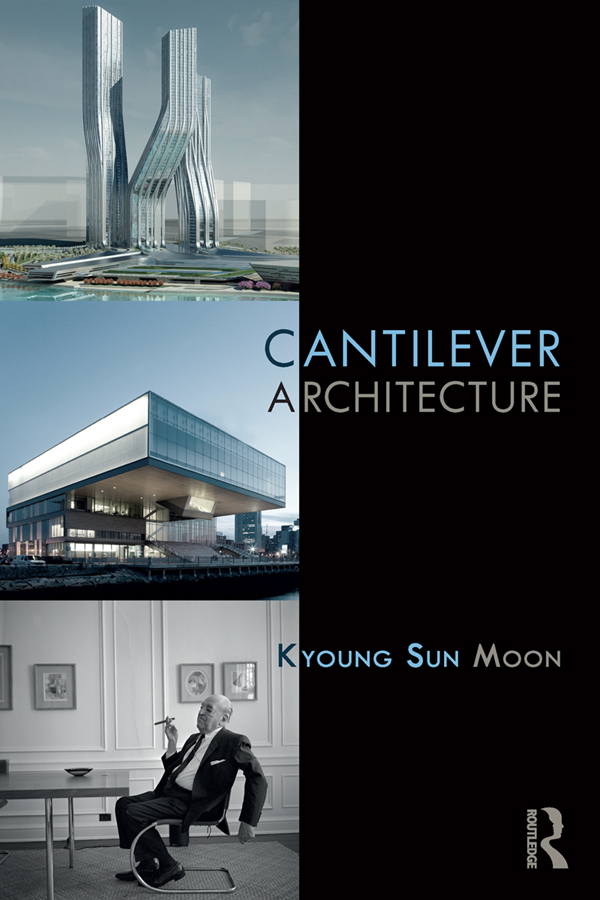
Architects are often fascinated by dramatic cantilevers. Indeed, cantilevers are widely used in architecture for various reasons and in different scales. This book is organized to present studies on the entire range of cantilevers employed in architecture: cantilevered furniture, cantilevered building components and significantly cantilevered major building parts, all primarily subjected to gravity loads; and finally a building as a whole, including supertall buildings of complex-shapes, as a vertical cantilever against lateral loads. Each chapter presents a specific subject on either horizontal or vertical cantilevers of different scales, functions and forms based on the following outline: brief historical review, basic structural principles, and holistic analysis of real world or theoretical examples. By presenting almost all different cantilever design scenarios in architecture, this book is a unique and essential reference on cantilever architecture.
Kyoung Sun Moon, PhD, AIA, is Associate Professor at Yale University School of Architecture. Educated as both an architect and engineer, his primary research area is integration between the art and science/technology of architecture, with a focus on tall and other structurally challenging buildings. Prior to joining the Yale faculty, he taught at the University of Illinois at Urbana-Champaign and worked at Skidmore, Owings, and Merrill in Chicago and the Republic of Korea Navy. He received his PhD from Massachusetts Institute of Technology.
KYOUNG SUN MOON

First published 2019
by Routledge
52 Vanderbilt Avenue, New York, NY 10017
and by Routledge
2 Park Square, Milton Park, Abingdon, Oxon, OX14 4RN
Routledge is an imprint of the Taylor & Francis Group, an informa business
2019 Taylor & Francis
The right of Kyoung Sun Moon to be identified as author of this work has been asserted by him in accordance with sections 77 and 78 of the Copyright, Designs and Patents Act 1988.
All rights reserved. No part of this book may be reprinted or reproduced or utilised in any form or by any electronic, mechanical, or other means, now known or hereafter invented, including photocopying and recording, or in any information storage or retrieval system, without permission in writing from the publishers.
Trademark notice: Product or corporate names may be trademarks or registered trademarks, and are used only for identification and explanation without intent to infringe.
Library of Congress Cataloging-in-Publication Data
A catalog record for this title has been requested
ISBN: 978-1-138-67418-9 (hbk)
ISBN: 978-1-138-67421-9 (pbk)
ISBN: 978-1-315-56144-8 (ebk)
Typeset in Univers
by Florence Production Ltd, Stoodleigh, Devon, UK
CANTILEVERS ABOUND in nature in many morphological and tectonic forms. Trees and mountains are the best examples of vertical cantilevers in nature that resist lateral wind forces. Historically, buildings and bridges have been using cantilevers to create projections that are employed either for structural or aesthetic reasons, or for both. With rapid advances in material and construction technologies during the past several decades, cantilevers are now appearing in buildings all around the world, in limitless forms and combinations. The design and engineering of cantilevers is also currently one of the utmost exhilarating, cutting edge, and vigorous fields of research in industry in various contexts.
Horizontal cantilevers in buildings are a very common sight. Interestingly, tall buildings are truly colossal vertical cantilevers by themselves spiking out of the ground towards the sky and are subjected to the fierce lateral forces of high winds and earthquakes. Even in building foundations, engineers use cantilevers to their advantage for different types of footings. Literature on cantilevers flourishes in scattered forms; architects and engineers employ them in solving many simple and complex problems in design offices and studios. Yet surprisingly, there is no book that explicitly and entirely focuses on the cantilever, which is becoming so popular in the modern world. Indeed, a book on this subject has been long overdue. Cantilever Architecture by Kyoung Sun Moon bridges that gap.
With architectural research currently dominated by the continuing structural emphasis on verticality and the race for the tallest construction, it seems timely now to focus on the unique and critical importance and value of the under-researched but increasingly germane architectural properties, possibilities, and challenges pertaining to cantilevers. The interesting features about the cantilevers are that they are aesthetically pleasing often with sculptural qualities endowed with quasi-dynamic forms that seem to fly in the air in static motion; they can minimize obstructive support structures and offer desirable versatility of application. They can be strategically employed in long-span structures to reduce bending and deflection of main spans. And their application is not limited to only buildings and bridges, but also to many industrial, mining, telecommunication and aviation structures.
Why is this book important? In partial answer to this question, others in the future will likely write books on this topic but few will have the qualifications of Kyoung Sun Moon. He is uniquely qualified to write this book as he is an architect, a structural engineer and a dedicated researcher. He has thoroughly dug into this subject and produced this generously illustrated book offering some fresh perspectives. No wonder his motivation to write this book stems from his keen observation of different types and applications of cantilevers. Because of his combined architectural and engineering background he has been able to successfully examine the technical aspects of cantilever systems and express them in qualitative terms.
In Cantilever Architecture Kyoung Sun Moon has presented an informative and refreshing account of fascinating exploration of cantilevers in lucid and understandable language. The work will be of great value to those in the architectural and engineering professions, as well as to students aspiring to learn in depth the intricate details of cantilevers. It demands careful study.
Mir M. Ali
Professor Emeritus of Architecture
University of Illinois at Urbana-Champaign
ARCHITECTS ARE OFTEN FASCINATED by the use of support-free structures to solve certain design problems. They often want a significant portion of their buildings to be supported without conventional columns or walls so the buildings have a feel of hovering. Two typical design approaches for the situation are direct horizontal cantilevering and hanging from the top. The latter, using tensile members, also usually requires a substantial cantilever structure at the top to hang the desired portion of the building from there.
Cantilevers have been used in buildings throughout the history of architecture. However, the scale of cantilevers was limited by the properties of traditional building materials. Supported by the development of stronger and stiffer modern structural materials, such as steel and reinforced concrete in the 19th century, and continued advancements of construction techniques, dramatic cantilevers of unprecedented scales began to emerge. Today, many buildings throughout the world find their design solutions using large cantilevers.
Next pageFont size:
Interval:
Bookmark:
Similar books «Cantilever Architecture»
Look at similar books to Cantilever Architecture. We have selected literature similar in name and meaning in the hope of providing readers with more options to find new, interesting, not yet read works.
Discussion, reviews of the book Cantilever Architecture and just readers' own opinions. Leave your comments, write what you think about the work, its meaning or the main characters. Specify what exactly you liked and what you didn't like, and why you think so.

